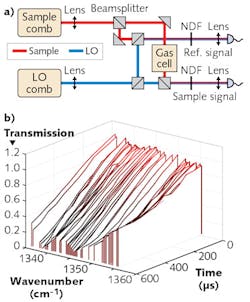Spectrometers: Mid-IR spectrometer uses quantum-cascade laser frequency combs

Recognizing that mid-infrared (mid-IR) frequency combs based on downconverted near-IR sources using nonlinear crystals can suffer from nonlinear interactions while continuous-wave (CW) laser-pumped microresonator-based combs depend on lossy bulk components with limited spectral range, engineers at IRsweep (Zurich, Switzerland) are using four-wave mixing of phase-locked quantum-cascade lasers (QCLs) to fabricate ultrastable, repeatable mid-IR frequency combs that are critical to the development of broadband, compact mid-IR spectrometers.1
With similar operation to frequency-modulated lasers, QCL-based frequency combs are available with center frequencies between 6 and 8 μm and inter-mode beat linewidth <10 Hz. Because the comb is generated by four-wave mixing in the QCL laser chip, the electrically pumped, monolithically integrated comb source is more robust and simpler than other systems, making it ready for integration into a compact spectrometer. This resultant broadband (66 cm-1), absorption-based, shot-noise-limited mid-IR spectrometer achieves a resolution of 10 MHz at a spectral sampling of 0.25 cm-1.Dual-comb QCL setup
The instrument, called the IRspectrometer, uses multiheterodyne beating of two QCL-based frequency combs with slightly different comb-line spacings. One comb is formed from an approximately 6-mm-long indium gallium arsenide/indium aluminum arsenide (InGaAs/InAlAs) QCL cavity and has approximately 200 comb lines with 7.5 GHz (0.25 cm-1) comb-line spacings, while the other comb has a slightly different line spacing to enable observation of the multiheterodyne spectrum within the analog bandwidth of the detector.
As in other dual-comb spectroscopy setups, one comb functions as a local oscillator while the other interrogates the sample (see figure). The frequency-modulated nature of the QCL frequency comb reduces the peak power incident on the detector, exploiting the dynamic range of the spectrometer-in fact, the signal-to-noise ratio of the QCL mid-IR dual-comb spectrometer is close to the shot noise of the system.
Experimental measurements of a low-finesse etalon and water vapor demonstrated a precision of 1.4% in a 40 ms integration time in early experiments. The commercially available IRsweep spectrometer has resolution of 10 MHz, spectral sampling <0.5 cm-1, and bandwidth of 150 cm-1 with several center wavelengths between 5 and 10 μm available in a physical footprint of 103 × 63 × 34 cm.
"We are excited to make the benefits of dual-comb spectroscopy in the mid-IR available to users who don't want to build their own system from scratch," says Markus Geiser, cofounder and managing director at IRsweep. "The instrument will be especially useful for applications requiring a high time resolution on the order of microseconds and use cases where high spectral bandwidth and high brightness are important. We look at applications in the life sciences, for example, where conformal changes in proteins can be observed in real time and through much thicker samples than with conventional FTIR spectrometers."
REFERENCE
1. A. Hugi, "Mid-Infrared spectrometer featuring μ-second time resolution based on dual-comb quantum cascade laser frequency combs," CLEO Conf., Photonic Instrumentation & Techniques for Metrology & Industrial Process, San Jose, CA (May 2017).

Gail Overton | Senior Editor (2004-2020)
Gail has more than 30 years of engineering, marketing, product management, and editorial experience in the photonics and optical communications industry. Before joining the staff at Laser Focus World in 2004, she held many product management and product marketing roles in the fiber-optics industry, most notably at Hughes (El Segundo, CA), GTE Labs (Waltham, MA), Corning (Corning, NY), Photon Kinetics (Beaverton, OR), and Newport Corporation (Irvine, CA). During her marketing career, Gail published articles in WDM Solutions and Sensors magazine and traveled internationally to conduct product and sales training. Gail received her BS degree in physics, with an emphasis in optics, from San Diego State University in San Diego, CA in May 1986.